中国传统节日介绍英文版讲课教案共45页
- 格式:ppt
- 大小:5.01 MB
- 文档页数:45
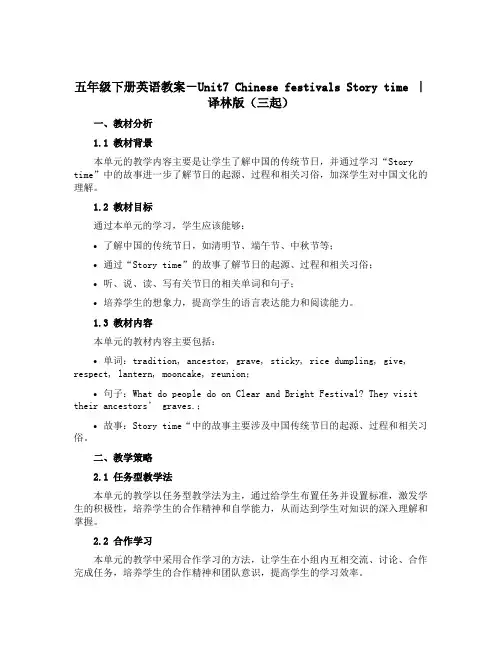
五年级下册英语教案-Unit7 Chinese festivals Story time |译林版(三起)一、教材分析1.1 教材背景本单元的教学内容主要是让学生了解中国的传统节日,并通过学习“Story time”中的故事进一步了解节日的起源、过程和相关习俗,加深学生对中国文化的理解。
1.2 教材目标通过本单元的学习,学生应该能够:•了解中国的传统节日,如清明节、端午节、中秋节等;•通过“Story time”的故事了解节日的起源、过程和相关习俗;•听、说、读、写有关节日的相关单词和句子;•培养学生的想象力,提高学生的语言表达能力和阅读能力。
1.3 教材内容本单元的教材内容主要包括:•单词:tradition, ancestor, grave, sticky, rice dumpling, give, respect, lantern, mooncake, reunion;•句子:What do people do on Clear and Bright Festival? They visit their ancestors’ graves.;•故事:Story time“中的故事主要涉及中国传统节日的起源、过程和相关习俗。
二、教学策略2.1 任务型教学法本单元的教学以任务型教学法为主,通过给学生布置任务并设置标准,激发学生的积极性,培养学生的合作精神和自学能力,从而达到学生对知识的深入理解和掌握。
2.2 合作学习本单元的教学中采用合作学习的方法,让学生在小组内互相交流、讨论、合作完成任务,培养学生的合作精神和团队意识,提高学生的学习效率。
三、教学步骤3.1 导入•教师可以通过展示有关中国传统节日的图片或视频,让学生先对节日有一定的了解和印象。
•教师可以让学生自由谈论自己最喜欢的节日,并引导学生通过对自己喜欢的节日的描述,逐渐了解和理解各种节日的不同特点和文化内涵。
3.2 教学重点本单元的教学重点在于教学故事和相关单词和句子,故事情节生动有趣,带有浓郁的中国文化气息,能够引起学生的兴趣和好奇心。

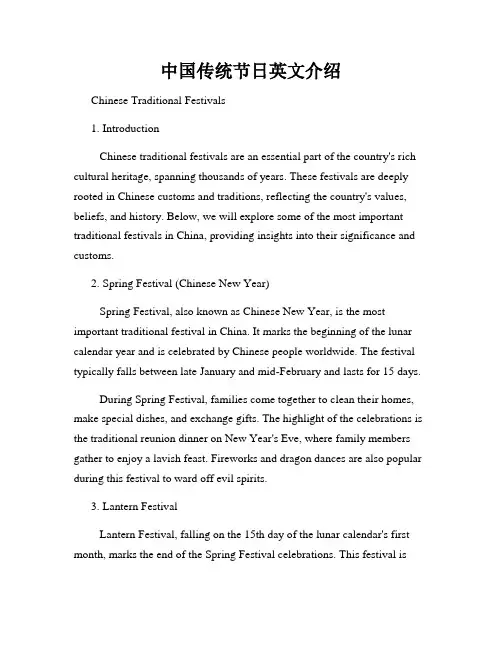
中国传统节日英文介绍Chinese Traditional Festivals1. IntroductionChinese traditional festivals are an essential part of the country's rich cultural heritage, spanning thousands of years. These festivals are deeply rooted in Chinese customs and traditions, reflecting the country's values, beliefs, and history. Below, we will explore some of the most important traditional festivals in China, providing insights into their significance and customs.2. Spring Festival (Chinese New Year)Spring Festival, also known as Chinese New Year, is the most important traditional festival in China. It marks the beginning of the lunar calendar year and is celebrated by Chinese people worldwide. The festival typically falls between late January and mid-February and lasts for 15 days.During Spring Festival, families come together to clean their homes, make special dishes, and exchange gifts. The highlight of the celebrations is the traditional reunion dinner on New Year's Eve, where family members gather to enjoy a lavish feast. Fireworks and dragon dances are also popular during this festival to ward off evil spirits.3. Lantern FestivalLantern Festival, falling on the 15th day of the lunar calendar's first month, marks the end of the Spring Festival celebrations. This festival ischaracterized by the display of colorful lanterns and various cultural activities.People often write riddles on their lanterns for others to solve, adding an element of fun and intellectual challenge to the festival. The iconic lanterns take many forms, including those shaped like animals, flowers, or famous landmarks. Watching the lanterns light up the night sky is a mesmerizing experience.4. Dragon Boat FestivalThe Dragon Boat Festival, also known as Duanwu Festival, is celebrated on the fifth day of the fifth lunar month. This festival commemorates the famous poet Qu Yuan and is characterized by the exciting racing of dragon boats.Dragon boat races involve teams of rowers paddling vigorously to the beat of a drum, competing to reach the finish line first. These races attract huge crowds of spectators who cheer and encourage the participants. Another significant tradition of this festival is the consumption of sticky rice dumplings called zongzi, which are wrapped in bamboo leaves.5. Mid-Autumn FestivalThe Mid-Autumn Festival, also known as the Moon Festival, is celebrated on the 15th day of the eighth lunar month. This festival is a time for family reunions and the appreciation of the full moon's beauty.The festival is closely associated with the legend of Chang'e, a celestial being who resides on the moon. During this festival, people gather to enjoy mooncakes, round pastries filled with various sweet or savory fillings.Lanterns in the shape of the moon are also prevalent during this festival, adding to the festive atmosphere.6. ConclusionChinese traditional festivals are not only grand celebrations but also an embodiment of the Chinese people's cultural identity and historical roots. Through these festivals, people reaffirm their bonds with family, pay respects to ancestors, and pass down customs and traditions to future generations.As China continues to modernize, it remains essential to preserve and cherish these traditional festivals as they play a vital role in maintaining cultural cohesion and fostering a sense of national unity. By understanding and appreciating these festivals, one can gain a deeper insight into the rich cultural tapestry of China.。
![中国传统节日文化(英语版)[优质ppt]](https://uimg.taocdn.com/6480620cc850ad02de804162.webp)
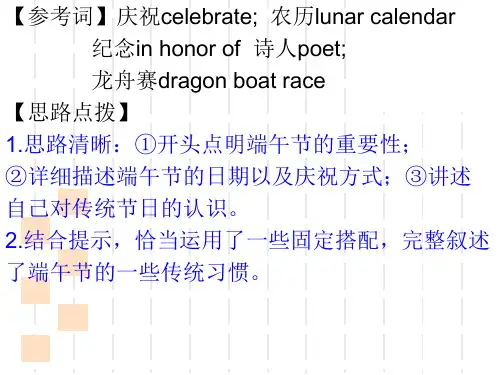
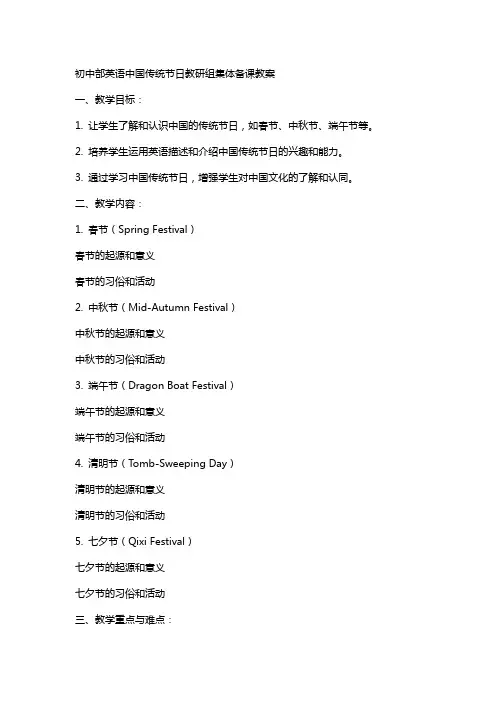
初中部英语中国传统节日教研组集体备课教案一、教学目标:1. 让学生了解和认识中国的传统节日,如春节、中秋节、端午节等。
2. 培养学生运用英语描述和介绍中国传统节日的兴趣和能力。
3. 通过学习中国传统节日,增强学生对中国文化的了解和认同。
二、教学内容:1. 春节(Spring Festival)春节的起源和意义春节的习俗和活动2. 中秋节(Mid-Autumn Festival)中秋节的起源和意义中秋节的习俗和活动3. 端午节(Dragon Boat Festival)端午节的起源和意义端午节的习俗和活动4. 清明节(Tomb-Sweeping Day)清明节的起源和意义清明节的习俗和活动5. 七夕节(Qixi Festival)七夕节的起源和意义七夕节的习俗和活动三、教学重点与难点:1. 重点:让学生能够用英语描述和介绍中国传统节日的起源、意义和习俗。
2. 难点:如何让学生在描述和介绍时,运用所学的英语语法和词汇。
四、教学方法:1. 任务型教学法:通过设定各种任务,让学生在完成任务的过程中,学习和掌握相关知识。
2. 情境教学法:创造各种情境,让学生在真实的情境中,运用所学知识。
3. 互动教学法:鼓励学生积极参与,进行小组讨论和分享,提高学生的参与度和积极性。
五、教学准备:1. 教师准备相关节日的资料和图片,以便在教学中进行展示和讲解。
2. 学生准备笔记本和笔,以便记录和整理所学内容。
六、教学过程:1. 引入:通过展示一张中国传统节日的图片,如春节的庙会,让学生猜测是哪个节日,引发学生对传统节日的兴趣。
2. 讲解:根据教学内容,讲解每个节日的起源、意义和习俗,展示相关的图片和资料,帮助学生更好地理解和记忆。
3. 任务:为学生设定一个任务,如小组合作,选择一个节日,用英语编写一个简短的介绍,包括起源、意义和习俗。
4. 展示:让学生分组上台展示他们完成的任务,其他学生和教师进行评价和反馈。
七、作业布置:1. 让学生选择一个中国传统节日,用英语写一篇小作文,描述其起源、意义和习俗。
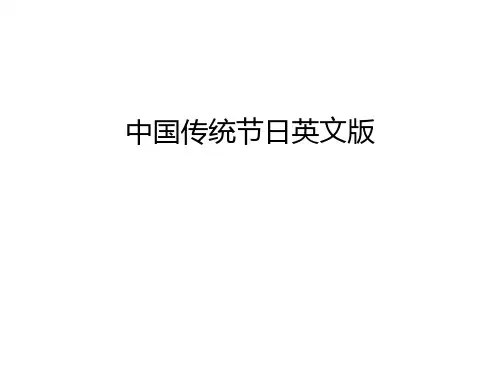

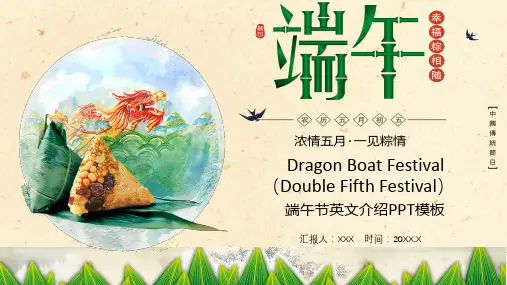
![chinese festivals中国传统节日英语介绍[优质PPT]](https://uimg.taocdn.com/29598d8e700abb68a982fbcb.webp)
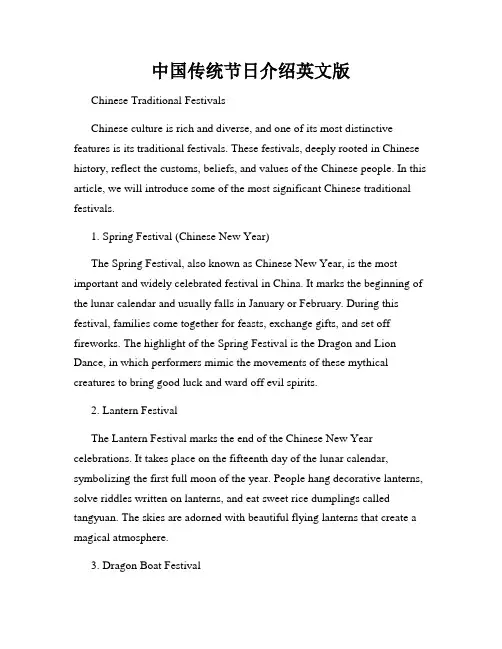
中国传统节日介绍英文版Chinese Traditional FestivalsChinese culture is rich and diverse, and one of its most distinctive features is its traditional festivals. These festivals, deeply rooted in Chinese history, reflect the customs, beliefs, and values of the Chinese people. In this article, we will introduce some of the most significant Chinese traditional festivals.1. Spring Festival (Chinese New Year)The Spring Festival, also known as Chinese New Year, is the most important and widely celebrated festival in China. It marks the beginning of the lunar calendar and usually falls in January or February. During this festival, families come together for feasts, exchange gifts, and set off fireworks. The highlight of the Spring Festival is the Dragon and Lion Dance, in which performers mimic the movements of these mythical creatures to bring good luck and ward off evil spirits.2. Lantern FestivalThe Lantern Festival marks the end of the Chinese New Year celebrations. It takes place on the fifteenth day of the lunar calendar, symbolizing the first full moon of the year. People hang decorative lanterns, solve riddles written on lanterns, and eat sweet rice dumplings called tangyuan. The skies are adorned with beautiful flying lanterns that create a magical atmosphere.3. Dragon Boat FestivalThe Dragon Boat Festival, also known as Duanwu Festival, is celebrated on the fifth day of the fifth lunar month. This festival commemorates the ancient poet Qu Yuan and commemorates his suicide by drowning himself in a river. Dragon boat races are held to reenact the search for Qu Yuan's body and to pay homage to him. People also eat sticky rice dumplings wrapped in bamboo leaves called zongzi during this festival.4. Mid-Autumn FestivalThe Mid-Autumn Festival, also known as the Moon Festival, is celebrated on the fifteenth day of the eighth lunar month. It is a time for families to gather and appreciate the full moon while eating mooncakes. Mooncakes are traditionally filled with sweet bean paste or lotus seed paste and often contain a salted egg yolk symbolizing the moon. The festival also includes lantern displays and the exchange of small gifts.5. Qingming Festival (Tomb-Sweeping Day)Qingming Festival, also known as Tomb-Sweeping Day, is a time to honor deceased ancestors. It usually occurs on April 4th or 5th of each year. During this festival, families visit the graves of their ancestors to clean and tidy the tombstones, make offerings, and burn incense. It is also a time for people to enjoy outdoor activities such as flying kites and hiking.6. Double Ninth FestivalThe Double Ninth Festival, also known as Chongyang Festival, is celebrated on the ninth day of the ninth lunar month. As the name suggests, this festival falls on a day with a double yang (阳) numerical order, which symbolizes strength and fortune. On this day, people often climb mountains,fly kites, and drink chrysanthemum wine to ward off evil spirits and pray for good health and longevity.7. Winter Solstice FestivalThe Winter Solstice Festival, also known as Dongzhi Festival, is celebrated on the shortest day and longest night of the year, around December 21st. It is a time for families to get together and enjoy a special meal. Tangyuan, a sweet glutinous rice ball, is a traditional food during this festival. Eating tangyuan symbolizes family reunion and the arrival of longer days as we move into winter.In conclusion, Chinese traditional festivals hold great significance in the hearts of the Chinese people, serving as a means to connect with their cultural roots, strengthen family ties, and express their hopes and wishes. The festivals mentioned above are just a glimpse into the rich tapestry of Chinese traditions, each with its unique traditions, customs, and beliefs. By celebrating these festivals, the Chinese people pass down their heritage from generation to generation, ensuring that their cultural identity remains alive and vibrant.。